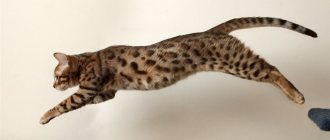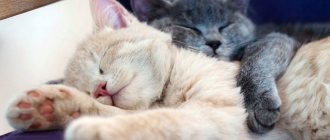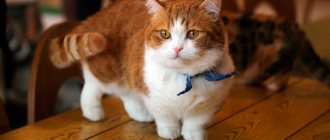| Country of origin | Siam (modern Thailand) |
| Weight | 4-8 kg |
| Wool | short |
| Lifespan | 14-15 years old |
| Other names | Old Siamese, classic, traditional, apple head. |
The favorite of kings, the Thai cat has one of the most ancient histories. For her loyalty and protection of her masters from evil spirits, she received sky-colored eyes as a reward. And this is not just one legend about the Thais. There are more than five of them about the origin of the breed alone.
Origin story
The history of Thai cats is mysterious. This is both a very ancient and at the same time new breed. It is known that a description of a cat with a light body, black ears and tail was found in the “Book of Poems about Cats” (14-15 centuries). Its name was Wichien Maet. Cats lived only in Buddhist temples and the palace of the ruler, for which they received the name “royal”. They had a special purpose - to drive away evil spirits and accompany people to another world in order to protect their souls. When the owner died, the cat was placed alive with him in the tomb. The secret is that the grave had many passages, and the animal could get out of there. When the cat returned after the funeral, it meant that the soul of the deceased had settled in it. The animal was given reverence. Due to their sacred role, the export of cats from the country was prohibited.
There is a version that the original color of Thai cats was dark and their eyes were yellow. During the mixing, the well-known color point, which belongs to the temperature-dependent group, and blue eyes appeared.
Until now, those who are far from breeding work confuse the Thai and Siamese breeds. These are 2 varieties with one ancestor - the Siamese cat, which came to Europe in the late 19th and early 20th centuries from Siam, as Thailand was previously called - the homeland of Thai cats.
The fact is that the cats brought from Siam were of different types. And everyone who was involved in breeding enhanced the traits of a certain species. In the 50s 20th century The Americans emphasized lightness of the skeleton, lengthening of the limbs, and the formation of a wedge-shaped head. The result was the modern Siamese breed. European felinologists adopted the American standard as a basis. And true Thai cats, which were not so graceful, thin and light, did not have a chance.
In Russia there were many lovers of cats with round, slightly heavy shapes and blue eyes. A surge of interest in the old type of Siamese cats occurred in the 70s. 20th century Although it is believed that animals appeared in Russia earlier - in the 90s. 19th century Nicholas II was given a gift from the Emperor of Thailand - 200 purebred individuals.
In the USSR, it was the Old Siamese breed that was bred - strong, muscular. At the end of the 80s of the 20th century. An exhibition organized by WCF took place in Moscow. Based on the results, in 1990 the Thai cat breed was approved and a standard was published.
Legends of appearance
There are 3 common legends about how Thai cats appeared in Europe:
- In 1870, Owen Gould, an official at the British Embassy in Bangkok, brought 2 cats from Siam. It was a gift from the emperor. Eastern beauties have conquered England; they have never been seen here before. The Thais enjoyed a stunning success at the exhibition at the Crystal Palace.
- According to the second version, the animals were brought to England by Anna Crawford, who served as governess to the children of the King of Siam. This happened in 1867.
- In 1871, the king sent 11 Siamese cats to England as gifts to high-ranking officials. It is believed that the history of the new breed began with them.
Answers to the scanword of the day from Odnoklassniki number 22001
- Spades card suit in another way from 4 letters: VINI
- in the photo from 7 letters: SCANDIUM
- From it grows a pig from 8 letters: PIG
- Bagheera's 3-letter colleague: KAA
- Fire - yang, water - ... from 3 letters: YIN
- Film “Mustachioed...” from 4 letters: NANNY
- in the photo from 7 letters: QUARTER
- Sedge swollen otherwise from 4 letters: ILAC
- Large 5 letter asteroid: ATALA
- 10 letter university graduate: UNIVERSITY
- 5 letter grapefruit drink: TONIC
- An ancient city in Japan with 4 letters: NARA
- The name of the VAZ-2101 SUV consists of 4 letters: NIVA
- “Mademoiselle sings the blues” (singer) from 4 letters: KAAS
- Medical specialty with 6 letters: OTIATR
- The opposite trope of the 6-letter hyperbole: LITOTE
- Corneille's 4-letter tragedy: OTOH
- Writer Marshall from 4 letters: ALAN
- Cards from end to beginning of 4 letters: TRUCK
- 11 letter climber: CLIMBER
- Piggy full of 7 letter coins: PIGGY BANK
- Lake…-Kul from 5 letters: ISSYK
- Tomato variety with 3 letters: INA
- Actor's work from 4 letters: GAME
- Straightened place from 6 letters: EXTENSION
- in the photo from 4 letters: RANA
- ...–curly made from 3 letters: FLAX
- One of the 3 letter pygmy groups: AKA
- Star pop quartet of 4 letters: ABBA
- Sword from the Land of the Rising Sun with 6 letters: KATANA
- Embryonic membrane of 6 letters: AMNION
- Sumerian 6 letter goddess: INANNA
- Former name of the car. 7 letter beep: KLAXON
- Rocker...3 Letter Zombie: ROB
- Avant-garde artist Yoko... from 3 letters: IT
- The very head is in the side according to Dahl from 4 letters: OLEK
- Fencing around the hatch with 4 letters: LEER
- 4 letter roller skates: SEBA
- in the photo from 4 letters: CRANE
- in the photo from 4 letters: ORSK
- Grass of the grass family from 6 letters: BELOUS
- French artist with 3 letters: RUO
- NHL star of yesteryear with 3 letters: ORR
- Russian artist with 4 letters: MOOR
- Homeland of cats and 4-letter twins: SIAM
- 3 letter fate: ROCK
- French star cinema...Jacob from 4 letters: IRENE
Description and standard
The Thai breed has medium compact size and well-developed muscles. At the same time it looks graceful and elegant.
The table provides a description of the breed:
| Become | Characteristic |
| Head | Has no sharp corners, rounded. The cheeks are well defined. The muzzle is marked with clearly smooth outlines. The chin is wedge-shaped. |
| The eyes are almond-shaped, large, slightly slanted. The color is blue, blue, the richer the better. It cannot be green or yellow. | |
| The ears have rounded tips and a wide base, located on the sides of the head. | |
| Body | Medium length, muscular, strong bones. The body is flexible, for which Thais are compared in grace to panthers. |
| Legs | Muscular, set in proportion. The paws are round and small. |
| Tail | Thick at the base and tapering towards the tip. The length is average. |
| Wool | The undercoat is insignificant. The hairs are short, silky, and fit tightly to the body. |
| Colors | Thermodependent (acromelanic). Preference is given to light fawn. The body should be colored evenly and contrast with the markings. Tail, paws, ears, muzzle are the same color. |
Thai cat: breed and color
In this beauty, seemingly incompatible things are combined in harmony: good muscles and elegance, a strong stocky build and flexibility. The cat remains medium in size even in adulthood. Its weight varies from 4 to 6 kilograms.
Body type
Compared to its successor, the Siamese cat, which has an elongated body and long limbs, the Thai cat has smooth lines, and a strong, muscular neck extends into a dense body. “Thais” are endowed with beautiful slender limbs with rounded paws and a small tail, which is slightly narrowed at the very tip and has a thickening at the base.
Portrait
The portrait of a typical Thai cat is an apple-round head and muzzle with a clearly defined bridge of the nose, which is located at eye level. This is the main difference from the Siamese, which is endowed with a wedge-shaped head.
Males are distinguished from females by their pronounced cheeks. The animal’s round, slanted eyes fascinate and attract like a magnet. Their pale blue, azure color, and the shine of sapphires are extremely beautiful. The cat's fur is short, with a medium undercoat, adjacent to the skin and surprisingly smooth and soft, reminiscent of an affectionate plush blanket.
Color
The dark eight markings mentioned in the ancient manuscript - on the paws, tail, ears and muzzle, with a light body color - exist in cats to this day. Today there are many color variations of the eight marks, from milky to very dark shades, among them:
- chocolate;
- deer;
- blue;
- caramel;
- cream;
- tortoiseshell;
- red.
Thai cat: colors
The real pride of Thai cats is their coloring. The dark, even black color of the paws, muzzle, ears and tail contrasts well with the light body. This color is called differently: “Siamese”, “pointed”, “acromelanistic”, “Himalayan”.
The color is unusual in that it blooms. The coat color of a newborn kitten is completely white. After a couple of weeks, the first marks begin to appear. The edges of the ears become dark, then the muzzle, tail and paws. The color is fully formed within a year. However, the process does not stop. With age, a Thai becomes increasingly darker and “blooms.” It is believed that this can be influenced by nutrition (consumption of buckwheat, liver, some dry food), sterilization, and temperature conditions. But the main factor is genetic.
Initially, Siamese had only 4 point colors:
- Sil – cream body, dark brown markings. The most popular color among cat owners.
- Blue - the body is white-blue, the protruding areas are gray-blue.
- Chocolate – milky chocolate markings on ivory.
- Lilac Point – white body with a slight tinge of ivory and brown-pink points.
After crossing with other breeds, the colors of Thai cats were updated. The following have been added:
- Red or red point - red color of markings.
- Cream – creamy, red colored points.
- Striped (tabby / tabby point or tabby point) or lynx point - stripes are clearly visible on the markings. Such cats always have a pattern in the form of the letter “M” on their heads.
- Tortoiseshell (tortie) – markings are red and cream. Only females can have this color.
It is believed that colorful Thai cats (torti) bring happiness to the house.
The rarest are tortoiseshell and red colors.
Thai cats: character
If there is a leapfrog in the house, there is a whirlwind of things, then the reason here is simple - the blue-eyed Thai cat.
The Thai is considered one of the smartest breeds in the world. Has a high learning ability. Bringing abandoned things is a common activity for them. They can learn to go to the toilet in the toilet. They get used to walking on a leash. They often belong to troupes of circus performers.
At the same time, due to its intelligence, the Thai cat can show leadership qualities and occupy the main position, demonstrating stubbornness.
The breed is agile, active and sociable. Thai cats get used to people, and not to their place of residence. Thais choose their own master and cannot be convinced.
They can be affectionate and restless at the same time. They are constantly on the move and doing things. A quiet life is not for them. All games for both kittens and adults are energetic. It is necessary to create a condition for the energy to splash out in a peaceful way: Thais love to run and are fond of mouse toys and balls. They retain their activity throughout their lives, as well as the desire to play.
Curiosity is an integral feature of Thai cats and a character trait. They are also distinguished by their lack of fear. The combination of curiosity and fearlessness is a leading cause of injury.
Thais know how to “talk”. In addition to “meow,” they have many sounds with different intonations in their arsenal. With their voice they can express joy, request, invitation, love. At the same time, all emotions are reflected on the face.
The appearance of the Thai cat in Russia
It is believed that Siamese cats were brought to our country in the 1950s of the last century by Sergei Obraztsov (director of the puppet tetra). Due to the fact that we began to engage in breeding work only in the middle of the 20th century, and also thanks to the “Iron Curtain,” the old type among our representatives of this breed remained unmodified.
We have almost the largest number of old breed Siamese left. In order to somehow distinguish between a modern specimen and a traditional one, and to put an end to the confusion, in 1990 it was proposed to call the cat of the old type Thai, after the current name of the kingdom of Siam, Thailand.
Despite the fact that the historical homeland of Thai cats is unimaginably distant, they have taken root in our country and feel great here.
Care and maintenance
Keeping Thais is not much different from other cat breeds with a short coat.
Grooming the coat is not difficult. It is enough to periodically remove fallen hairs with a rubber brush or a hand dipped in water. Despite the short fur there will still be a lot of it.
You need to take care of your oral cavity to avoid plaque and tartar. From childhood, a kitten is taught to brush its teeth. The procedure is unpleasant and resistance is guaranteed. Therefore, you can buy special toys for your pet to remove plaque.
Claws are trimmed once every 2 weeks or as needed.
Thais are active. You need to remember this: close the balcony, install bars and limiters on the windows.
What to feed a Thai cat
For Thais to live a long life, they need to take a responsible approach to feeding.
| Authorized Products | Prohibited Products |
| Beef, poultry (chicken, turkey), rabbit. It is better to choose sinewy pieces and cut into strips. The cat must chew and develop its jaw. The meat is scalded or frozen. | Fatty meat (pork, lamb, duck). Sausages. |
| Heart, lungs, chicken stomachs. | Liver is excluded from the diet for its coloring properties. |
| Sea fish, squid - no more than 2 times a month and boiled. | Seafood and food based on it. The coat darkens from such a diet, and excessive consumption of fish increases the risk of developing urolithiasis. |
| Rice as an additive to meat. | Buckwheat (affects the color of the coat), rolled oats, beans, potatoes. |
| Cottage cheese, fermented milk products. For kittens up to 6 months of age cream. Quail eggs. Chicken yolk. | Milk is not recommended for adult cats. |
| Any vegetables and fruits that your pet likes. | Coloring vegetables (beets, carrots), as well as seaweed and food containing them. |
| Olive, linseed oil 1 tsp. in Week. You can fat, which is formed near the kidneys and liver. | Fish and chicken bones. |
| Vitamins | Fatty, salty, smoked foods. Salo. |
| Super-premium dry food, canned food. | Chocolate, salt, spices. |
Poor nutrition, sudden changes in diet, and cheap food increase the risk of pancreatitis and gastritis.
A nursing cat's food needs to be higher in calories in order to produce enough milk for the development of the babies. Kittens grow quickly.
Kitten weight by month:
| Age | Weight (in g) |
| Newborn | 117 |
| 1-1.5 weeks | 235 |
| 1 month 1 Week | 450 |
| 2.5 months | 900 |
Health
Thai cats have strong immunity. Representatives of the breed may exhibit defects such as squint, crease (not correction) of the tip of the tail. But flaws in appearance do not affect health at all.
However, there are a number of diseases that are most common in Thai and Siamese cats:
- bowel cancer;
- baldness;
- dysfunction of the esophagus;
- asthma;
- heart defect (congenital);
- increased pain sensitivity;
- glaucoma;
- breast cancer.
Thais are temperamental in matters of love. When a cat is in heat, she behaves inappropriately and screams loudly. And high hormonal levels are the cause of cancer of the uterus, mammary glands, and inflammation of the ovaries. Sterilization is considered the best disease prevention. Castration reduces the risk of developing urolithiasis.
Vaccinations
Most pets lead a domestic lifestyle, but they also need vaccinations.
Rules:
- 8-12 weeks – first vaccination. A month later, revaccination. Then they are vaccinated every year.
- If the mother cat has been vaccinated, then the kitten is vaccinated at 12 weeks; if not, at 8.
- 10 days before vaccination, the animal is dewormed.
In practice, doctors use complex vaccines against several diseases at once. These are the drugs Novibak, Quadrikat, Multifel, Felovax.
How long do Thai cats live at home?
Thai cats are long-lived. On average they live 14-15 years. However, it is not uncommon for them to live up to 20 or even 28 years. This largely depends on the conditions created, what to feed the pet, and genetic factors.
The homeland of Thai cats is the Kingdom of Siam
In Siam, cats have been revered since ancient times. The history of the appearance of Thai cats dates back to the 14th century. To this day, the ancient manuscript “Poem about Cats” remains, which describes 17 cats that bring good luck. Among them is the Siamese.
The cats brought were the highest gift from the King of Siam. With the growth of popularity, unfortunately, the appearance of the animal began to change. From stocky and well-fed, they began to turn into thin and sonorous. In 1958, the Siamese cat standard was adopted in England, which established a commitment to lengthening the silhouette and making it lighter. The new type was finally established by the 80s, but the old one was safely forgotten.
How to choose a kitten
The best time to take a kitten home is at least 2 months old. Exhibition animals are sold after 5-6 months, when the teeth have completely changed. And the best age when you can evaluate the baby’s exterior and exhibition future is 4 months.
The main criteria for choosing a kitten are simple: it must be healthy, be able to go to the toilet on its own, and preferably use a scratching post.
Gender doesn't matter. An uncastrated cat will mark where he likes, and an unsterilized cat will meow loudly and demand love. And such characteristics of the breed as cunning, cunning, and stubbornness are characteristic of both boys and girls. The only cats are more affectionate and careful than cats.
Each Thai breeder has his own price for a kitten. The determining factor of how much a purebred Thai kitten costs is class. For show class pets the highest price is from 25 thousand rubles, breed class – 10 thousand rubles, pet class can be purchased from 5 thousand rubles.
How to name a kitten
The character of Thai cats and the history of the breed provide the owner with many options for choosing a name for his pet.
You can choose from Thai names that are pronounced with the emphasis on the last syllable:
| Nickname for a boy kitten | Nickname for a girl's kitten |
| Aron, Vaen, Det, Kosum, Kitty Krysi, Chris, Mai, Manoj, Nai, Nok, Phen, Khan, Mongkut, Narong, Niran, Thaksin, Lek, Dao, Nok, Kai, Samon, Kosum, Apple, Yu | Agum, Dara, Dao, Spark, Kama, Mali, Bunsi, Buppa, Mali, Vaen, Nari, Num |
These nicknames are just hints. They say that all you have to do is look into the sky-blue eyes of a kitten, and he will come up with an idea.
Advantages and disadvantages
All representatives of the cat world have advantages and disadvantages. The Thai cat is no exception.
Positive features:
- affectionate, sociable;
- smart;
- do not require special care;
- strong immunity;
- live long.
Negative points (based on reviews):
- do not tolerate loneliness well;
- for some owners - talkativeness, especially during estrus;
- complex nature;
- can be vindictive and harmful.
Education and training
For those who love peace, order and comfort in their home, a Thai cat is not the best choice, but for those who do not like loneliness, the Thai cat breed can fill life with new impressions and new emotions. These are not only active, but also affectionate and loving animals. Such an animal should be raised from an early age, especially since Thai cats are easy to train due to their excellent training abilities, as well as their flexible intelligence.
It is necessary to constantly communicate with this animal, otherwise you can hardly count on mutual understanding. The Thai cat easily picks up all the intonations in the voice of its owner and knows that a slightly raised tone of voice calls for severity and means a prohibition, but the cat perceives a soft tone as some kind of encouragement. Under no circumstances should you use too loud a voice or punish your pet. If you approach the process of education and training competently and professionally, then a Thai cat can easily master basic commands, such as “sit”, “lie down”, “no”, as well as other commands and even tricks that are very difficult, as for cats.
Horoscope compatibility
Zooastrologers identify several signs that will become true friends and companions with Thai cats.
Aries are energetic, impulsive and often stubborn. Therefore, a Thai cat, whose energy is in full swing and is ready to play constantly, will get along well with Aries and will not let him get bored.
Thais are sociable, do not like loneliness, and often show independence. Because of these character traits, they will be excellent companions for Leos.
Scorpios are passionate, passionate, willful, and have a good understanding of people. A Thai cat suits them like no other.
The breed will make friends with people born under the sign of Sagittarius. Thais are just as active and friendly.
Character traits
The pet always gets along very well with the owner and takes into account his mood.
The Altai cat will immediately become a friend to the owners who accepted it into the family. She will not bother you over trifles, but she will definitely come to play with pleasure if she feels favored by the owners. This breed of cat loves small children, plays with them, and can lie down to rest next to a sleeping baby. These pets happily participate in outdoor games with kids. Blue-eyed cats are considered lovers of sleep. It is imperative to pay attention to how conversations are conducted with the animal, since they are very touchy by nature. This breed of cat needs personal space. They are uncomfortable, scared and uncomfortable on the street. The most suitable place to keep blue-eyes is an apartment. Animals are inquisitive, so they will always notice any changes in the decor of the house and will study new items for a long time. This also applies to new people in the room, guests, neighbors. A cat loves to be admired, talked to, and shown tenderness and care towards her.











